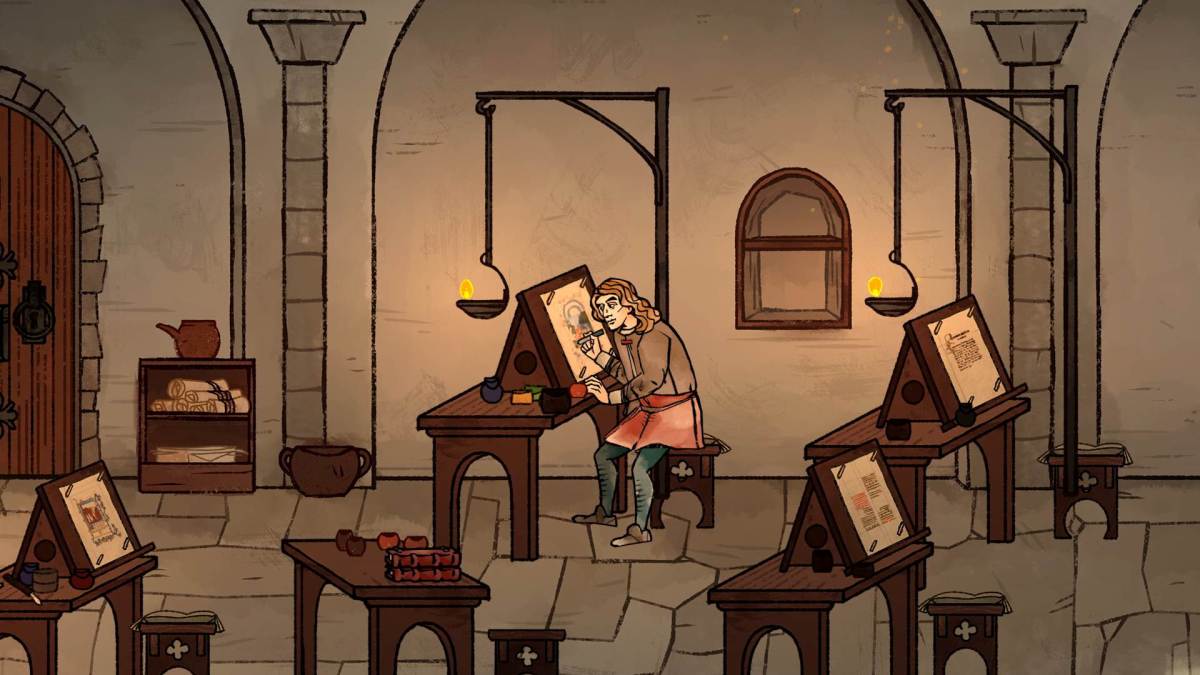Living history
When you first see Pentiment, it’s quite plainly different from most other games. It’s a historical thriller, an adventure told in another era using art, sounds, and design conducive to the overall feeling of life in 16th century upper Bavaria.
It’s no surprise, then, that this is a passion project for the developers at Obsidian putting it together. We got a chance to take a look at some of Pentiment ahead of Gamescom and participate in a Q&A with some developers behind the project. And it didn’t take long for Pentiment to seize my attention.
Pentiment follows Andreas Maler, an artist working in a scriptorium. Though just a journeyman, Andreas becomes embroiled in a series of murders over the course of 25 years. In the process, he’ll be tasked with investigating the murders and, hopefully, bringing the truth to light.
The entire art style of Pentiment is incredibly accurate to the art and aesthetic of the 16th century. Obsidian’s team, made up of 13 developers, spent a lot of time digging into history. Part of it was for the explicit art style, but another part was to just get the general feel of life in this era.
Art director Hannah Kennedy says the team looked at different paintings from the time period, and artists from that region, to get contextual info on how people lived back then.

Life and type in motion
These details stem out and seep into even the game mechanics. Each character’s lettering is based on their own background and upbringing. A clergy member might lay out empty lettering that gets filled in with ink afterwards. But this was near the rise of the printing press, and so someone working in that industry might have their dialogue stamped in by lettering tiles, in machine-like fashion.
The murder-mystery has to contend with methods of the time as well. Game director Josh Sawyer notes that many common forensic tools are not available to the player due to the time period, and even the justice system may seem odd to a modern player.
“There’s a lot of ambiguity here, and you’re put in a position where you have to kind of pin the murder on somebody,” said Sawyer. “And it’s never going to be clear, if that’s really the person.”

You just have to make a judgment call and decide. Pick the best option available. Or hey, pick someone you don’t like. The punishment for murder in the 16th century is, well, pretty serious. That’s a way to deal with a thorn in your side, so to speak. I reached out for clarification on this, and a spokesperson told me there is no “right” outcome. The narrative will adapt to the player’s choices, and different options will lead to different consequences.
“So yeah, we really want you to see the consequences of these play out over a long period of time,” said Sawyer. “That being said, there is a really strong central narrative that is connected to Andreas, that’s pulled through the entire story. And so yeah, we’re trying to do the classic thing where we interweave the choice and reactivity within a very strong storyline.”
Reach out and touch faith
Of course, this being the 16th century, religion and faith play a major role. One pointed moment that Obsidian showed as an example was a minigame, where Andreas was assisting a woman by arranging the items on her wall.
It’s a neat little minigame, and Obsidian wants these to be character moments that are designed for the vibes and bringing you into the world. But at one point, the woman requests that you remove the cross from her wall. She’s unhappy with the church, and it provides a moment for the player to acquiesce or assert themselves.

Role-playing is still a part of Pentiment, even if it’s a narrative adventure with RPG elements rather than a full-on role-playing game. The player gets to determine Andreas’ background, and make choices as him that will echo throughout the story. Some might be major, some might be minor.
Take, for example, the choice of where to eat your meals. Getting to know someone might give you an option later on, making it easier to convince them to help you. Or maybe it won’t. These are tools that the narrative team at Obsidian utilizes to reflect the player’s choice in the story, though it’s trying to keep it within reason.
“We try not to get bogged down in visibly tracking this stuff,” said Sawyer. “Meaning we don’t have meters or things like that. We just try to track the things that feel like characters would pay attention to. We let you know when they’re paying attention to them, and when they come up in conversation again.”

A historical whodunnit
Removing traditional systems like, say, combat or gathering, let the Obsidian crew work on building a lived-in world. And it really shows. What I saw of Pentiment looks like a passion project from developers who wanted to try something new.
Of special note is the accessibility options Obsidian is including, too. While the flowery lettering and text looks great, especially in a historical context, it’s not the easiest to read for everyone. Sawyer says the team has been assisted by Microsoft’s usability group in testing. Features like the high-contrast mode came from that, and they got testing on their easy-read fonts and scaling as well.
What’s certain is that Pentiment seems like a unique experience, mixing murder and intrigue with art and history. It’s a passion project for the developers that put it together, and seems well-positioned to be a surprise hit when it arrives later this year.
Pentiment will launch on Xbox Series X|S, Xbox One, and PC via Steam and Windows. It will also launch on Game Pass for both Xbox and PC.













Published: Aug 24, 2022 11:00 am